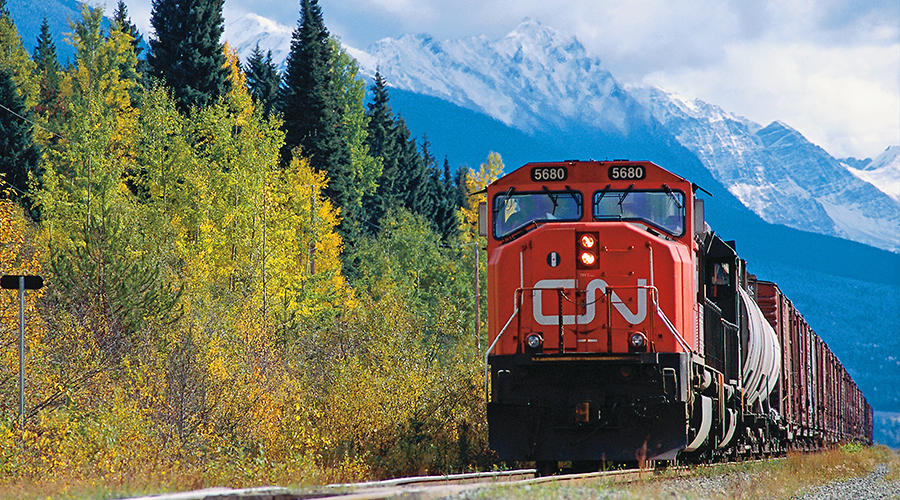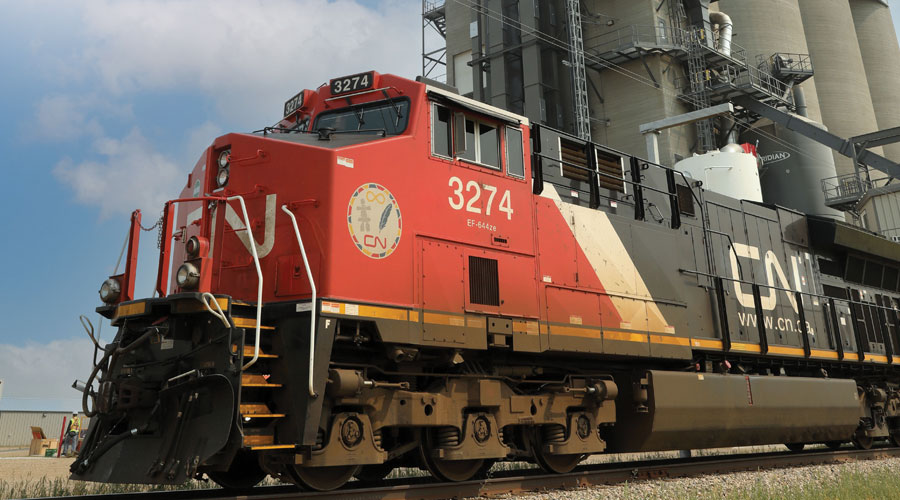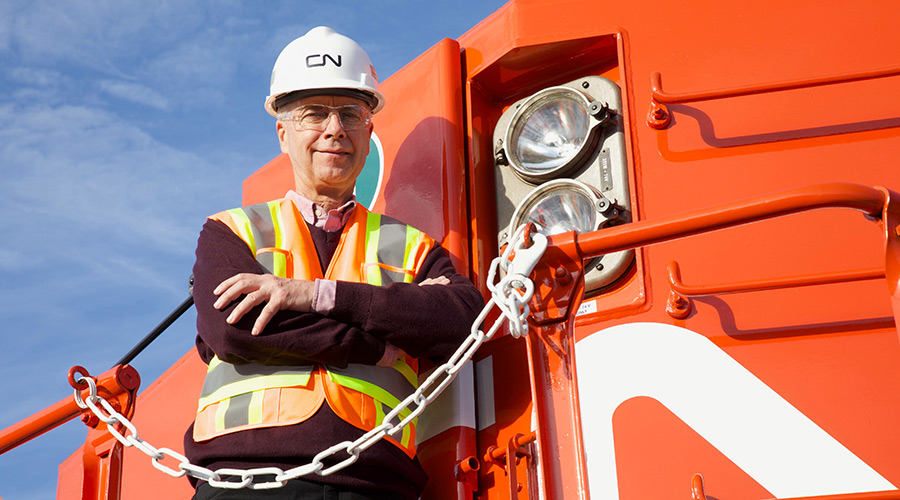Stay updated on news, articles and information for the rail industry
May 2020
Rail News: Canadian National Railway - CN
CN aims to maintain stay-resilient, stay-lean strategy to overcome business lost to the pandemic
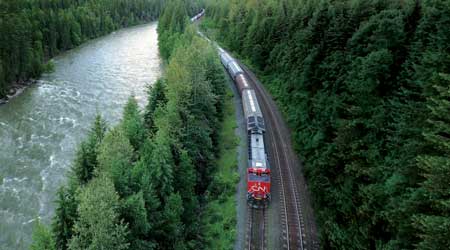
By Jeff Stagl, Managing Editor
A labor strike in November. Protest blockades along several key lines in February. The COVID-19 pandemic emerging and accelerating in March. And on top of that, the usual severe winter weather during the first quarter.
To say the five-month period from November 2019 to April 2020 was difficult for CN is a huge understatement. It was perhaps the most trying and disruptive such period in the Class I’s nearly 101-year history — and it’s not even over. The series of events caused routing disruptions and shutdowns, temporary and permanent layoffs, traffic downturns, and cost and resource cuts.
But the experiences in that period haven’t been crushing, at least not as of late April. They were more a testament of the resiliency of the company and its employees, and a prime example of the important role the railroad plays in getting everyday essential goods to markets, said CN Executive Vice President and Chief Operating Officer Rob Reilly in an email.

The company remained disciplined in its recovery planning and execution efforts to deal with the strike and blockade, he said. The week-long strike in November by the Teamsters Canada Rail Conference involving 3,200 conductors and yard coordinators negatively impacted finances and operations. And the more than 30 blockades on lines in Ontario, Manitoba and British Columbia in February to support the Wet’suwet’en Nation delayed or canceled more than 1,400 trains, caused shutdowns on portions of CN’s lines and prompted the Class I to lay off 450 employees in eastern Canada.
“We were able to return to normal operating ranges very quickly after the strike in November and the rail blockades in March because we had the capacity and the resources to do so,” said Reilly, who also has served as interim chief information and technology officer since Michael Foster departed CN in late November last year.
Meanwhile, the COVID-19 outbreak has been extremely disruptive, but will fall short of stifling if the company minds its stay-resilient and stay-lean strategy, CN senior executives say. Although the coronavirus has caused economic uncertainty and global chaos, the ongoing pandemic is further evidence of the essential nature of CN’s service to its customers and the general population, said Reilly.
“The current economic environment is obviously extremely challenging and unpredictable. This is uncharted territory for all of us,” he said. “With COVID-19 blurring the horizon, we need to remain focused on rightsizing to meet the current demand while being ready to ramp back up as soon as the issue of the pandemic clears.”
CN is positioned favorably on what figures to be a long and winding road to recovery — perhaps one that doesn’t lead to any significant business growth until 2021 — because of efforts undertaken over the past several years to mold the railroad into one that can continue to perform well during unexpected events and market downturns, senior execs say.
Learn from the past
The Class I also will call on experiences derived from managing through previous “unusual times,” as senior execs characterize the current virus-stifled period. During the Great Recession that started in 2008, CN’s annual revenue ton miles (RTMs) fell 10 percent and revenue dropped 13 percent in 2009, prompting cost cuts that included trimming headcount by 4 percent and suspending share repurchases. Then during the freight recession that began in 2015, the company’s RTMs and annual revenue both declined by 5 percent in 2016, leading to a 9 percent headcount reduction and tight control on overtime and other expenses.
The railroad has and will continue to bounce back from economic swings, severe weather and operational disruptions, in part by controlling costs, senior exces say. Over the past two years, the company also has made substantial investments in capacity expansions and technological advancements, which are driving productivity and efficiencies, and will contribute to recovery efforts.
Meticulous planning and “a deep hard look” as to where capital should be spent helped target investments to better serve gateways, customers and many supply chains, said Reilly.
“These last few months have proven that the $7.4 billion in capital we have invested over the last two years is definitely worth every penny,” he said. “All this makes us more nimble in the face of unforeseen events.”
Infrastructure-improvement investments made in 2018 and 2019 included adding double track primarily in western Canada, and completing major trackwork projects across western Canada to improve capacity and fluidity, especially at West Coast ports. Among them, CN completed two major export supply chain projects that helped maximize the use of rail into the Port of Prince Rupert in British Columbia: improved infrastructure for thermal coal moving from Coalspur’s Vista Mine in Hinton, Alberta, to Ridley Terminals, and the movement of propane from Alberta via a new AltaGas export propane terminal on Ridley Island.
Although total capital expenditures in 2020 now will be scaled back by CA$200 million to CA$2.9 billion due to economic uncertainty, CN remains committed to investing CA$1.6 billion in track infrastructure maintenance.
In terms of rolling stock investments, CN has been spending capital of late to develop a more efficient and reliable locomotive fleet, and bolster the rail-car fleet. Last year, the company purchased 140 locomotives and acquired various cars; in 2020’s first half, the railroad still expects to receive 40 high-horsepower locomotives and 300 hopper cars.
Stay techno-savvy
Recent technological investments — which are targeted at enhancing CN’s precision scheduled railroading operational strategy — are furthering efforts to automate track inspections and trains, and develop paperless recordkeeping for train crews.
The Class I has deployed an autonomous track inspection program that employs wireless communications to test and monitor real-time geometric track parameters without interrupting operations, and installed a number of train inspection portals in Canada and the United States that provide real-time images and data for car inspection criteria.
Currently, the company is working with The Lion Electric Co. to design and build eight tandem-axle, Class 8 electric trucks as part of a larger strategy to reduce emissions through innovation. Additional technologies remain under analysis to determine their applicability, such as artificial intelligence, data science operationalization, intelligent agents, augmented reality and multicloud orchestration.
To improve the railroad’s own orchestration, several moves were made over the past year-plus to better manage assets and resources, and streamline some operations. CN moved all Canadian rail traffic control centers to Edmonton, Alberta, centralized network operations and reduced its number of regions from three to two.
“The steps we have taken to centralize the management of our assets and resources into one location has definitely helped us to quickly recover as one network and will serve us well into the future,” said Reilly.
Yet, despite all the strategic moves of late and relatively strong first-quarter financial performance, the immediate future doesn’t appear to be very bright due to the pandemic.
CN mostly overcame the blockades in Q1, although revenue was flat at CA$3.5 billion and carloads decreased 6 percent year over year to 1.34 million units. Net income jumped 29 percent to CA$1 billion, diluted earnings per share rose 4 percent to CA$1.22, operating expenses dropped 5 percent to CA$2.3 billion and the operating ratio improved 3.8 points to 65.7 compared with Q1 2019 figures.
Short-term slowdown
The pandemic likely will cause volumes to drop significantly in April, May and beyond, senior execs believe. In terms of both traffic and financial performance, the second quarter will be tough, followed by a flat third quarter and a fourth quarter that perhaps begins to reflect some potential recovery, CN President and Chief Executive Officer Jean-Jacques Ruest said April 2 during a Citigroup Research online and teleconference.
Looking farther ahead, the potential for a strong 2021 is high both for traffic and financial rebounds as shippers work to fulfill pent-up demand, he said.
Although some financial market analysts expect a steep and fairly quick V-shaped rebound from COVID-19, CN expects a prolonged U-shaped freight recovery because it will take some time for consumer spending to ramp up and for factories to boost production, Ruest said.
“If the consumer is not consuming, eventually the stuff really has no place to go,” he said during the conference.
For now, refineries, pulp mills and chemical plants are still running at a good clip, but they will slow down as people continue to stop buying cars and other consumer goods, Ruest believes. The auto business might not recover until 2021 or 2022, he predicts.
The Class I’s most promising markets for the remainder of 2020 and into 2021 are grain, export coal, export propane and domestic intermodal, Ruest said. CN set grain-moving records in March and April at nearly 2.5 million metric tons and 2.65 million metric tons, respectively.
“One of the areas where grain is very strong is to the Port of Rupert, but also obviously it’s the Port of Vancouver,” said Ruest.
Volumes of export of coal — both metallurgical and thermal — also have been strong of late, as have propane export traffic counts, which tie back to the new propane terminal at the Port of Prince Rupert, he said.
Other areas of strength: international intermodal as Asian imports rebound and domestic intermodal that’s gaining a boost from acquisitions completed in 2019. In an effort to add more supply chain offerings, CN last year purchased both The TransX Group of Cos. — which provides various transportation and logistics services, including intermodal — and H&R Transport Ltd.’s intermodal division. Both are mostly door-to-door domestic, long-haul and temperature-controlled domestic intermodal services that combine rail and truckload.
“These businesses that we bought last year are running flat out, because that’s probably what is most needed today is restocking a hardware store and restocking a food store, both of which have been essential services,” said Ruest.
Leaning on a leaner strategy
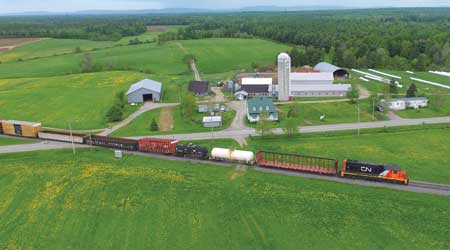
Unfortunately for CN, what’s been essential to survive Q1 and now weather the pandemic is cost and resource reductions. As of March 31, the Class I had trimmed headcount by 3,100 — or by 16 percent, including consultants — and cut the train-and-engine workforce by more than 20 percent compared with Q1 2019 levels. The railroad also stored 500 locomotives and reduced cars on line more than 15 percent.
Moreover, mechanical work in more than 20 shops was reduced and switching yards were idled in Battle Creek, Michigan; Jackson, Mississippi; Garneau, Quebec; and Kamloops, B.C.
But as resources and assets are right-sized to volume demands, any reductions are carried out “with a purpose and plan,” said Reilly. For example, locomotives are stored in good working condition so they can quickly return to service if necessary, and cars are stored strategically in anticipation of where they’ll be needed first.
“We [also] stay in regular and frequent contact with our furloughed employees so that they are aware of business volumes and demands to help them prepare for a return to work,” said Reilly.
Despite the disruptions and unexpected events that led to the right-sizing efforts, CN did register productivity and efficiency benefits in Q1. On a year-over-year basis, the railroad reduced active trains by more than 20 percent, boosted both car velocity and train speed by 10 percent, trimmed through-dwell time by 7 percent and increased fuel efficiency by 6 percent.
Going forward, productivity, efficiency and resiliency will continue to serve CN well as it strives to navigate the recovery course, Ruest said April 27 during the railroad’s Q1 earnings conference. The company will continue to seek technological deployments, exploit its structural advantages and pursue a “strategic pipeline of growth opportunities,” he said.
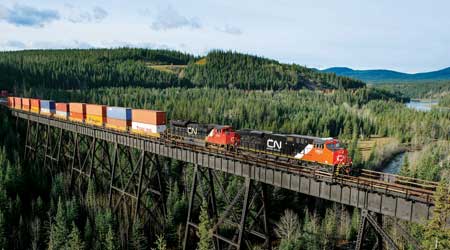
Those opportunities include new plastics plants and grain elevators; the ramp up of a coal spur in western Canada; the Ridley Island coal and propane terminals; container terminal expansions in greater Vancouver; a new Minneapolis auto compound; a CargoCool temperature-controlled service that’s growing in popularity; a CN/CSX interline container partnership in Montreal; and a new Quebec City intermodal terminal coming in spring 2024 due to a partnership with Hutchison Ports and the Port of Quebec.
“The structural advantage of our network that touches three coasts, has the advantage of being the only railroad to service Prince Rupert, and has the most seamless route around and through Chicagoland will continue to serve us well into the future,” said Reilly. “CN is known for being a pioneer and an innovator in railroading. That spirit is alive and well within the company, and will ensure we come out of this pandemic healthy and ready to deliver long-term value.”
Management also knows how to be nimble and precise when it matters because the railroad has been through trying times before, he said. Plus, CN expects to benefit from its diversified revenue base.
COVID-19 has not affected all customers equally, with some continuing to ship at a strong clip while others were forced to close facilities. So, recovery is a question of balance and timing, Reilly believes.
“Our strength is to know where to right-size our resources and to always plan for the day when you need to start ramping up,” he said.
Email questions or comments to jeff.stagl@tradepress.com.


 LRW Honors Amtrak’s Acheson As Railway Woman Of The Year
LRW Honors Amtrak’s Acheson As Railway Woman Of The Year
 From Editor-In-Chief Foran: Of Gender Equity And Inclusion
From Editor-In-Chief Foran: Of Gender Equity And Inclusion
 Spotlight On Some Of Today’s Rail Safety Products
Spotlight On Some Of Today’s Rail Safety Products
 Women of Influence in Rail eBook
Women of Influence in Rail eBook
 railPrime
railPrime




